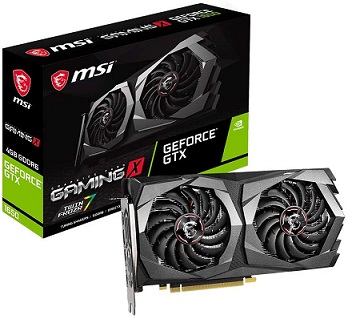Even though these graphics cards are a couple of generations old, they are still popular in budget builds and “used” computers.
A Brief Note on GTX 1650
Nvidia first launched the GeForce GTX 1650 in April 2019. It is an entry-level GPU based on the Turing microarchitecture and is suitable for gaming in low settings as well as basic video rendering.
Best RTX 3090 Graphics Card Best RTX 3070 Graphic Cards Best Low Profile Graphics Cards Best RTX 2070 Super Graphics Cards Best 6800 XT Cards How to Fix Geforce Experience Error Code 0x0003 NVIDIA RTX 3060 Ti Vs. NVIDIA RTX 3070
Initially, the GTX 1650 (code name TU117-300) came with GDDR5 memory support. But after a year of its original launch, Nvidia updated the memory to GDDR6 in April 2020, while retaining the same graphics core (TU117). A couple of months later, the GTX 1650 came as two upgraded variants, but this time with two different graphics cores (TU116 and TU106). Despite the upgrades in the graphics cores, all variants of GeForce GTX 1650 GPU have 896 CUDA Cores. Also, the original GDDR5-based GTX 1650 has a base clock of 1485 MHz and a boost clock of 1665 MHz. Now, if we compare these numbers with the later models, they all have a base clock of 1410 MHz and a boost clock of 1590 MHz, which is less than the original one. All variants of GTX 1650 GPU came with 4GB of Memory (be it GDDR5 or GDDR6).
A Brief Note on GTX 1060
Let us go back a couple of years. In July 2016, Nvidia launched the GeForce GTX 1060, a mid-range graphics card in the GeForce GTX “10” Series. It was based on the Pascal microarchitecture and manufactured using TSMC’s 16 nm process.
The original GTX 1060 was launched with 6GB or GDDR5 memory with a GP106 graphics core. There is also a 3GB variant with the same graphics core and a 6GB GDDR5X variant with a GP104 graphics core. All variants of GTX 1060 have a base core clock of 1506 MHz and a boost clock of 1708 MHz. Also, there are 1280 CUDA cores in the GeForce GTX 1060 GPU.
Specifications of GTX 1650 vs 1060
The following table has some important specifications of GTX 1650 as well as GTX 1060.
Comparison of GTX 1650 vs 1060
Let us start the comparison of GTX 1650 vs 1060 with the number of CUDA cores in each GPU. The GTX 1060 has 1280 CUDA cores while the GTX 1650 has only 896. This difference will definitely impact their performance, be it synthetic benchmarking, gaming, or rendering. For instance, the GTX 1060 averaged 3.85 TFLOPS while the GTX 1650 averaged only 2.98 TFLOPS. There is also a difference in the amount of video memory (RAM) as well as the variant. For instance, all GTX 1060 graphics cards have 6GB GDDR5 RAM. But the GTX 1650 has two options, one with GDDR5 and one with GDDR6. Both these RAM variants have only 4GB of memory configuration. The base clock or GTX 1060 is significantly higher than the GTX 1650. If we compare the clock frequencies, then GTX 1060 has 1506 MHz whereas the GTX 1650 has only 1485 MHz (GDDR5) or 1410 MHz (GDDR6). Boost clocks are also higher for GTX 1060. It has a 1708 MHz boost clock. But GTX 1650 has 1665 MHz (GDDR5) or 1590 MHz (GDDR6).
Performance of GTX 1650 vs 1060
From the above specs themselves, we can see that the GTX 1060 is a better card than the GTX 1650, despite being 3 years old. We tested these two GPUs with some popular titles. Here are our observations.
1080p with Ultra settings
1080p with High settings
1440p with Medium settings
From the above numbers, the GTX 1060 comfortably beats the GTX 1650 in all the games and display settings. We never had any doubts regarding the performance of GTX 1060. For those who own a GTX 1060 and have the FOMO of the GTX 1650, well, you don’t have to worry. Overall, the GTX 1060 is a better graphics card with slightly higher clock speeds and TDP than the GTX 1650.
Conclusion
Nvidia’s GTX 1060 and GTX 1650 are a couple of entry to mid-level graphics cards. These cards are best suited for those who are on a tight budget but still want o experience a decent gaming performance. In this guide, we saw the basic specs of GTX 1650 and GTX 1060. They have different microarchitectures (GTX 1060 is Pascal while GTX 1650 is Turing). We also made a side-by-side comparison of GTX 1650 vs 1060. After that, we saw some performance numbers of these two graphic cards. Comment * Name * Email * Website
Δ







![]()